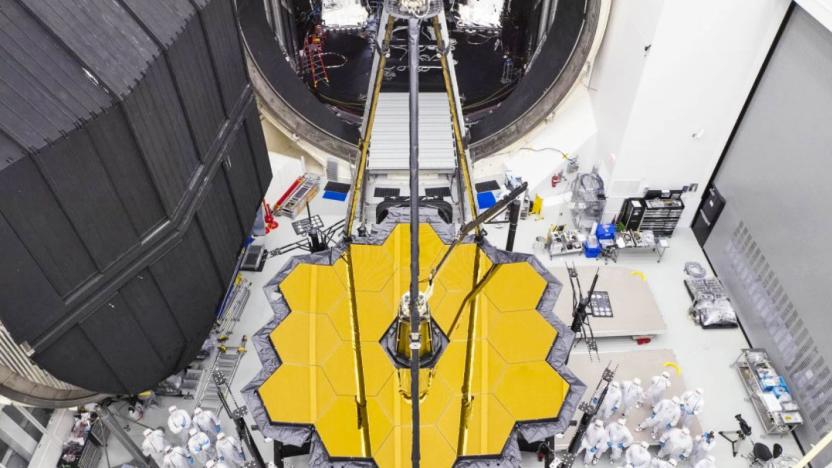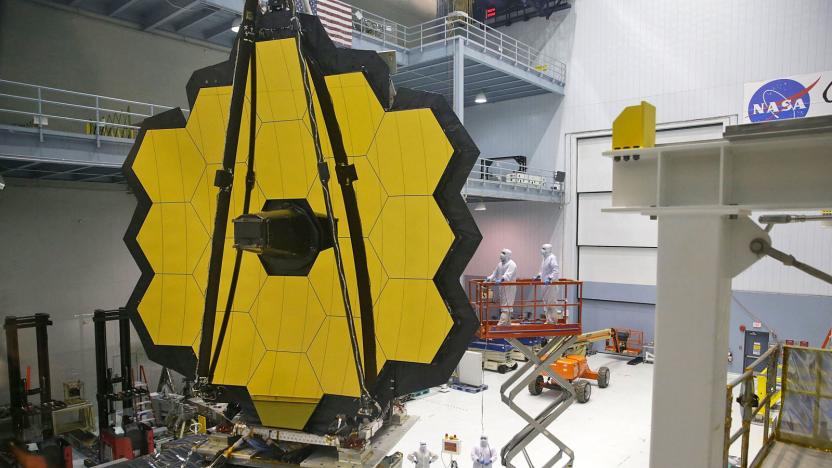JamesWebb
Latest

NASA's James Webb telescope is one step closer to launch
NASA's $8.8 billion James Webb Space Telescope (JWST) has just left the thermal vacuum chamber where it's spent more than three months being put through its paces in a series of hardcore cryogenic tests. Scientists wanted to make sure the telescope's instruments and optical element can function properly in the cold, airless conditions of space, and while NASA studies the results, engineers are busy putting JWST back together again, in preparation for its launch in spring 2019.

NASA pushes James Webb Space Telescope launch to Spring 2019
If you're counting down the days until NASA's Hubble replacement takes off, you'll have to count a bit longer. The James Webb Space Telescope was due to launch around a year from now. But, there seems to be (another) holdup. The aeronautics agency is blaming the delay on the remaining integration of spacecraft parts taking "longer than expected." As a result, the launch date is now being pushed to Spring 2019, specifically between March and June of that year. NASA assures that the rescheduled lift off is not due to any "hardware or technical performance concerns."

NASA has completed the $8.7 billion James Webb space telescope
The Hubble Space Telescope has given humanity unprecedented glimpses into the universe, but it will soon be replaced by a far more powerful model. NASA administrator Charles Bolden unveiled the completed $8.8 billion James Webb Space Telescope (JWST), which will be able to see the universe as it was 13 billion years ago. It's equipped with a 21-foot, gold-coated mirror array that can collect seven times more light than Hubble and scan the infrared spectrum to see through dust. "We've done two decades of innovation and hard work, and this is the result," project scientist John Mather says.

NASA extends the Spitzer mission for two-and-a-half years
When the Spitzer telescope blasted off to space on August 25th, 2003, NASA didn't think it would still be doing science by 2016. But since it's alive and well 13 years later, the agency has granted it a two-and-a-half-year mission extension to make discoveries the astronomers "never imagined exploring with the spacecraft." The space telescope's next stage officially called the "Beyond phase" will begin on October 1st this year. It represents a period in the elderly spacecraft's life fraught with engineering challenges due to its age.

NASA installs the first mirror on the Hubble's replacement
NASA announced on Wednesday that it had successfully installed the first of 18 mirrors on the new James Webb space telescope. The work took place at NASA's Goddard Space Flight Center in Greenbelt, Maryland earlier this week.

NASA's new telescopes could spot alien life within 20 years
Convinced that there's got to be life on other planets? You're not alone in the universe -- in fact, many NASA scientists agree with you. And a panel convened recently by the space agency (see the video below) believes that finding it could happen soon, too -- perhaps "in twenty years" -- thanks to incoming telescope technology. Recent projects, like the Kepler Telescope, Dark Energy Survey and the Very Large Telescope have detected the presence of planets and even their atmospheres. But astronomers are even more excited about future projects like the Transiting Exoplanet Surveying Satellite (TESS) and James Webb Space Telescope, set to launch in 2017 and 2018, respectively.

Alt-week 8.25.12: robotic noses, Nodosaurs and Space X launches again
Alt-week peels back the covers on some of the more curious sci-tech stories from the last seven days. All good things come to an end, they say. Thankfully, most bad things do, too. So while the rest of the world of tech is dealing with the fallout, and possible implications of patent law, over here in the wild party that is Alt, we're fist pumping at all the awesome weekly sci-tech fodder. For example, we've got a robo-nose that can sniff out nasties in the air, a 110-million-year-old footprint found in NASA's back yard, and not one, but two space stories to reflect on. There's a hidden joke in there too, come back once you've read through to find it. This is alt-week.

NASA to launch Hubble space telescope successor in 2018, will clean its room later
You know you're going to miss the Hubble Space Telescope once ceases operation and they let it simply burn up in orbit. But don't cry, dry your eye, the National Aeronautics and Space Administration has announced plans to put its successor, the James Webb Space Telescope, in orbit in 2018. The telescope, which will be 100 times more sensitive than the Hubble, faced being cut completely by a Congressional subcommittee earlier this year as a result of budget constraints given its $8.8 billion price tag. After much Capital Hill grilling over the project being billions over budget, NASA has moved is scheduled launch -- initially set for 2013 -- to October of 2018. Although not the best news, it'll still get up there and you can hug your Hubble plushie tightly tonight knowing distant worlds will be that much closer.






